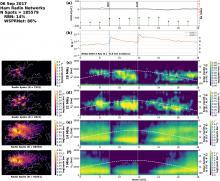RBN/WSPRNet Response to September 2017 Storms Published in Space Weather
RBN/WSPRNet Response to September 2017 Storms Published in Space Weather

A new study, High‐Frequency Communications Response to Solar Activity in September 2017 as Observed by Amateur Radio Networks, by HamSCI researchers has been published in the American Geophysical Union journal Space Weather. The article is available for free from the journal website.
Plain Language Summary: Radio communications using the high‐frequency (HF) bands (3–30 MHz) is important for emergency communications because it is the only form of electronic communications that can travel over the horizon without relying on man‐made infrastructure such as the Internet, satellite systems, or phone networks. This is possible because HF rays can be bent back to Earth by the ionosphere, an electrically charged layer of the upper atmosphere. Space weather events such as X‐ray flares from the Sun and geomagnetic storms can alter the ionosphere to disrupt these communications. During September 2017, a significant number of solar flares and geomagnetic activity occurred. Simultaneously, major hurricanes, including Hurricane Irma and Hurricane Jose, caused situations in the Caribbean region requiring the use of emergency HF communications, often provided by ham (amateur) radio operators. This paper shows the impacts of these space weather disturbances on HF communications as observed by multiple ham radio monitoring systems.
